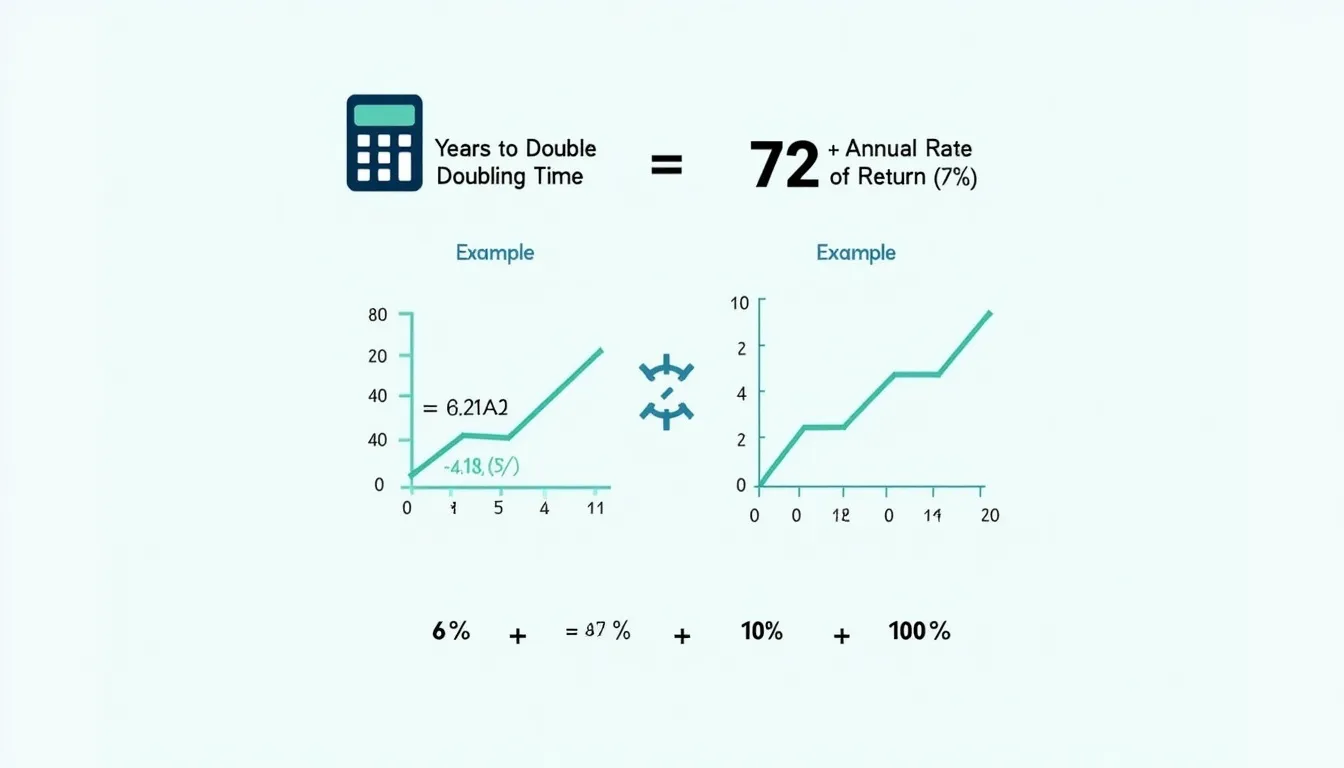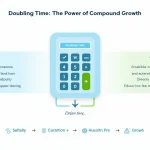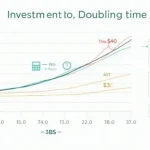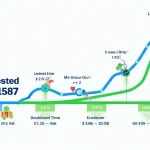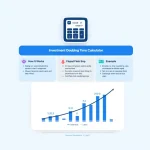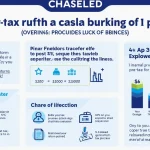Rule of 72 Calculator
Is this tool helpful?
Rule of 72 Calculator: Discover How Fast Your Investments Can Double
How to Use the Rule of 72 Calculator Effectively
Our Rule of 72 Calculator is designed to help you quickly estimate how long it will take for your investments to double in value. Here’s a step-by-step guide on how to use this powerful financial tool:
- Locate the “Rate of Return (%)” input field in the calculator.
- Enter your expected annual rate of return as a percentage. For example, if you expect a 7% return, simply enter “7”.
- Click the “Calculate” button to generate your result.
- The calculator will display the approximate number of years it will take for your investment to double based on the provided rate of return.
It’s important to note that this calculator assumes a constant rate of return over time. In reality, investment returns can fluctuate, but the Rule of 72 provides a useful approximation for financial planning purposes.
Understanding the Rule of 72: A Powerful Financial Concept
The Rule of 72 is a simple yet powerful financial concept that helps investors estimate the time it takes for an investment to double in value, given a fixed annual rate of return. This rule of thumb is widely used in finance and investing due to its simplicity and effectiveness in providing quick mental calculations.
The mathematical formula for the Rule of 72 is:
$$ \text{Years to Double} = \frac{72}{\text{Annual Rate of Return (\%)}} $$This approximation works particularly well for returns between 6% and 10%, which are common in many investment scenarios. While it’s not exact for all rates, it provides a remarkably accurate estimate for a wide range of growth rates.
The Origin and Significance of the Number 72
You might wonder why the number 72 is used in this rule. The choice of 72 is based on a mathematical approximation that works well with common interest rates and growth percentages. It’s derived from the natural logarithm of 2 (approximately 0.693) multiplied by 100 and rounded to the nearest whole number.
The beauty of using 72 lies in its divisibility. It can be easily divided by many small numbers (2, 3, 4, 6, 8, 9, 12), making mental calculations simpler for a wide range of growth rates.
Benefits of Using the Rule of 72 Calculator
Our Rule of 72 Calculator offers numerous advantages for investors, financial planners, and anyone interested in understanding the growth potential of their investments:
- Quick Estimation: Get instant results without complex calculations or financial software.
- Financial Planning Aid: Helps in setting realistic investment goals and timelines.
- Comparative Analysis: Easily compare different investment options or scenarios.
- Educational Tool: Understand the power of compound interest and long-term investing.
- Decision-Making Support: Assists in making informed decisions about savings and investments.
- Time-Saving: Eliminates the need for manual calculations or complex spreadsheets.
Empowering Financial Literacy
By providing a simple way to visualize investment growth, the Rule of 72 Calculator plays a crucial role in improving financial literacy. It helps users grasp the concept of compound interest and the importance of long-term investment strategies, encouraging more informed financial decision-making.
Addressing User Needs and Solving Investment Puzzles
The Rule of 72 Calculator addresses several key needs for investors and financial planners:
1. Investment Growth Projection
For investors wondering how long it will take to double their money, this calculator provides a quick answer. By inputting different rates of return, users can see how various investment strategies might impact their wealth accumulation over time.
2. Retirement Planning
Retirement planners can use this tool to estimate how many times an investment might double before retirement age. This information is crucial for determining if current savings and investment strategies are sufficient to meet retirement goals.
3. Comparing Investment Options
When faced with multiple investment opportunities, the Rule of 72 Calculator allows for quick comparisons. Users can easily see which option might lead to faster wealth accumulation, aiding in decision-making processes.
4. Understanding the Impact of Fees
By considering the effect of fees on net returns, investors can use this calculator to understand how expenses might impact long-term growth. For example, if an investment promises a 10% return but charges 2% in fees, inputting 8% into the calculator shows the true doubling time.
5. Setting Realistic Expectations
The Rule of 72 helps in setting realistic expectations for investment growth. It clearly illustrates that higher returns lead to faster doubling times, but also helps users understand that even small differences in return rates can have significant long-term impacts.
Practical Applications and Examples
To better understand how the Rule of 72 Calculator can be applied in real-world scenarios, let’s explore some practical examples:
Example 1: Stock Market Investment
Suppose you’re considering investing in a stock market index fund that has historically returned about 7% annually. Using the Rule of 72 Calculator:
- Input: 7% (Rate of Return)
- Result: Approximately 10.29 years to double
This quick calculation shows that, at a 7% annual return, you can expect your investment to double roughly every 10 years. This information can help you plan for long-term goals like retirement or children’s education funds.
Example 2: High-Yield Savings Account
Let’s say you’ve found a high-yield savings account offering a 2% annual interest rate. Using the Rule of 72:
- Input: 2% (Rate of Return)
- Result: Approximately 36 years to double
This result illustrates why savings accounts, while safe, may not be ideal for long-term wealth growth. It could take 36 years for your money to double, which might not keep pace with inflation.
Example 3: Real Estate Investment
Consider a real estate investment opportunity promising an annual return of 12%. Using the Rule of 72 Calculator:
- Input: 12% (Rate of Return)
- Result: Approximately 6 years to double
This quick calculation shows the potential power of high-return investments. However, it’s crucial to remember that higher returns often come with higher risks.
Example 4: Comparing Investment Options
Imagine you’re deciding between two investment options:
- Option A: 9% annual return
- Option B: 6% annual return
Using the Rule of 72 Calculator for both:
- Option A: 72 / 9 = 8 years to double
- Option B: 72 / 6 = 12 years to double
This comparison clearly shows the significant impact that a 3% difference in annual returns can have over time. Option A would double your investment 4 years faster than Option B.
Frequently Asked Questions (FAQ)
1. How accurate is the Rule of 72?
The Rule of 72 provides a good approximation, especially for annual returns between 6% and 10%. For rates outside this range, it may be less accurate but still gives a useful estimate. For more precise calculations, especially at very low or very high rates, more complex financial formulas may be necessary.
2. Can the Rule of 72 be used for negative growth rates?
While the Rule of 72 is typically used for positive growth rates, it can theoretically be applied to negative rates to estimate how long it would take for an investment to lose half its value. However, our calculator is designed for positive rates only.
3. Does the Rule of 72 account for taxes and inflation?
No, the Rule of 72 does not automatically account for taxes or inflation. To consider these factors, you should use your after-tax, after-inflation rate of return in the calculator.
4. Can I use the Rule of 72 for daily or monthly compound interest?
The Rule of 72 is designed for annual compound interest. For more frequent compounding periods, you may need to adjust the rate or use more complex calculations for precise results.
5. Is there a Rule of 114 or Rule of 144?
Yes, these are variations of the Rule of 72. The Rule of 114 estimates how long it takes for an investment to triple, while the Rule of 144 estimates the time for an investment to quadruple. They work similarly to the Rule of 72.
6. How does the Rule of 72 relate to compound interest?
The Rule of 72 is a simplified way to understand the effects of compound interest. It helps visualize how compound interest can accelerate wealth growth over time.
7. Can the Rule of 72 be used for non-financial applications?
Yes, the Rule of 72 can be applied to any exponential growth scenario. For example, it can estimate how long it would take for a population to double given a certain growth rate.
Please note that while we strive for accuracy, we cannot guarantee that the webtool or results from our webtool are always correct, complete, or reliable. Our content and tools might have mistakes, biases, or inconsistencies. Always consult with a qualified financial professional for important financial decisions.
Conclusion: Harness the Power of the Rule of 72
The Rule of 72 Calculator is a powerful tool that simplifies complex financial concepts, making them accessible to everyone. By providing quick estimates of investment doubling times, it empowers users to make more informed financial decisions and better understand the long-term potential of their investments.
Key benefits of using this calculator include:
- Rapid assessment of investment growth potential
- Easy comparison of different investment options
- Better understanding of the power of compound interest
- Aid in long-term financial planning and goal setting
- Improved financial literacy and decision-making skills
Whether you’re a seasoned investor, a financial planner, or someone just starting to explore the world of personal finance, the Rule of 72 Calculator is an invaluable tool in your financial toolkit. It provides a simple yet effective way to visualize the growth of your investments over time, helping you make smarter decisions about your financial future.
We encourage you to use this calculator regularly as part of your financial planning process. Experiment with different rates of return to see how they impact your investment growth timeline. Remember, while the Rule of 72 provides useful estimates, it’s always wise to consult with a financial advisor for personalized advice tailored to your specific situation.
Start using our Rule of 72 Calculator today and take the first step towards more informed, strategic financial planning. Your future self will thank you for the wisdom and foresight you demonstrate today!
Important Disclaimer
The calculations, results, and content provided by our tools are not guaranteed to be accurate, complete, or reliable. Users are responsible for verifying and interpreting the results. Our content and tools may contain errors, biases, or inconsistencies. We reserve the right to save inputs and outputs from our tools for the purposes of error debugging, bias identification, and performance improvement. External companies providing AI models used in our tools may also save and process data in accordance with their own policies. By using our tools, you consent to this data collection and processing. We reserve the right to limit the usage of our tools based on current usability factors. By using our tools, you acknowledge that you have read, understood, and agreed to this disclaimer. You accept the inherent risks and limitations associated with the use of our tools and services.
